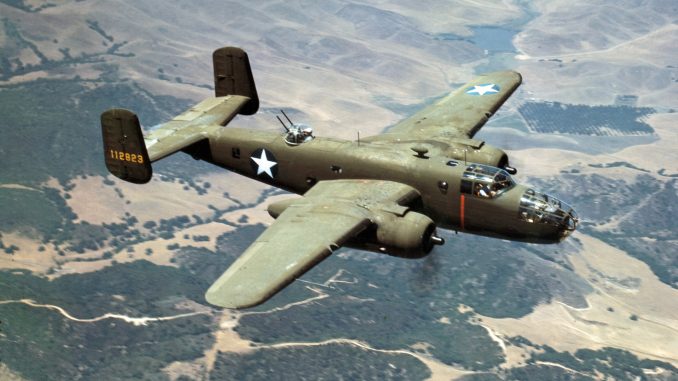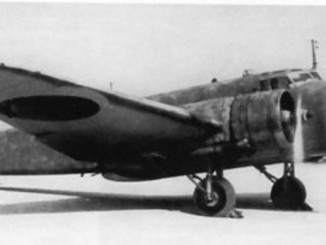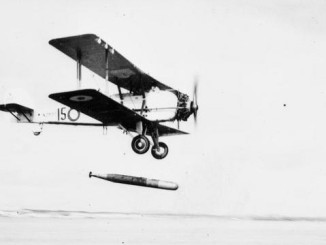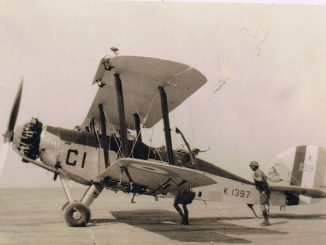
In 1937, the US Army Air Corps began to look for a new twin-engine attack bomber to replace the single-engine types it had on hand. The USAAC solicited for several designs, three of which ended up seeing war service: the Martin XA-22 Maryland, the Douglas A-20 Havoc, and the North American NA-40. North American’s design was initially rejected, but it was re-worked for the Army’s new medium bomber requirement in 1939 and the North American B-25 Mitchell was selected as the winner.
The B-25, named for aviation pioneer BGen William “Billy” Mitchell, initially had a crew of five: pilot, co-pilot, navigator, bombardier, and gunner. It had tricycle landing gear, something of a novelty for the time, and distinctive twin tails. It was powered by two of the dependable Wright R-2600 engines. It could carry a maximum bomb load of 3,000lb over 2,000 miles. The B-25 began to enter service in 1941, and the first groups equipped with the Mitchell began to ship out for the Pacific in early 1942.
The B-25 made its combat debut during the “Royce Mission”, when a detachment of 10 Mitchells purloined from a consignment destined for Dutch service flew to the Philippines in April 1942 and carried out a series of clandestine bombing missions, before evacuating dozens of men. A few days later 16 B-25s flew one of the most famous missions of World War II, the Doolittle Raid, when they took off from the carrier Hornet to bomb Tokyo.
B-25s soon became one of the most important aircraft in the Pacific, serving a variety of roles. When medium altitude bombing results proved poor, the 5th Air Force pioneered low level “skip-bombing” attacks which proved very successful at sinking Japanese shipping. Specialist variants of the B-25 were equipped with extra machine guns and even 75mm guns to make them even more deadly during low altitude attacks. Mitchells were a core component of the 5th, sweeping across New Guinea and into the Philippines as part of MacArthur’s famous return.
Several countries were provided with Mitchells via lend-lease, including Britain, China and the Soviet Union. British B-25s were used in Burma alongside their American counterparts, often being used as transports – Orde Wingate, leader of the famous ‘Chindits’ died when the Mitchell he was travelling in crashed. B-25s were also allocated to the US Marine Corps, which designated them as PBJ Mitchells under the Navy designation system.
B-25s continued in service long after the war ended, with the air forces of several countries continuing to fly them into the 1970s.
North American B-25 Mitchell Specifications
| North American B-25 Mitchell | |
| Role | Medium bomber |
| Crew | 5 |
| Powerplant | 2x Wright R-2600-9 (1,700hp) |
| Speed | 322mph (max) |
| Ceiling | 30,000ft |
| Range | 2,000 miles (internal) |
| Armament | 1x Browning M2 .50cal Machine Gun 3x Browning AN-M2 .30cal Machine Gun |
| Ordnance | |
| Dimensions | 54ft 1in (length) 67ft 6in (wingspan) 16ft 4in (height) |
| Wing Area | 610 sq.ft. |
| Weight | 17,258lb (empty) 28,557lb (max) |
| Number produced | 24 |
| North American B-25A Mitchell | |
| Role | Medium bomber |
| Crew | 5 |
| Powerplant | 2x Wright R-2600-9 (1,700hp) |
| Speed | 262mph (cruise) 315mph (max) |
| Ceiling | 27,000ft |
| Range | 1,350 miles (internal) |
| Armament | 1x Browning M2 .50cal Machine Gun 3x Browning AN-M2 .30cal Machine Gun |
| Ordnance | |
| Dimensions | 54ft 1in (length) 67ft 6in (wingspan) 15ft 9in (height) |
| Wing Area | 610 sq.ft. |
| Weight | 17,870lb (empty) 27,100lb (max) |
| Number produced | 40 |
| North American B-25B Mitchell | |
| Role | Medium Bomber |
| Crew | 5: Pilot, co-pilot, bombardier, navigator, radio operator |
| Powerplant | 2x Wright R-2600-9 (1,700hp) |
| Speed | 300mph (max) |
| Ceiling | 23,500ft |
| Range | 2,000 miles (internal) |
| Armament | 4x Browning M2 .50cal Machine Gun 1x Browning AN-M2 .30cal Machine Gun |
| Ordnance | 3,000lb bombs |
| Dimensions | 53ft 0in (length) 67ft 8in (wingspan) 15ft 9in (height) |
| Wing Area | 610 sq.ft. |
| Weight | 20,000lb (empty) 28,460lb (gross) 31,000lb (max) |
| Number produced | 134 |
| North American B-25C Mitchell | |
| Role | Medium Bomber |
| Crew | 5: Pilot, co-pilot, bombardier, navigator, radio operator |
| Powerplant | 2x Wright R-2600-13 (1,700hp) |
| Speed | 233mph (cruise) 284mph (max) |
| Ceiling | 24,000ft |
| Range | 1,500 miles (internal) |
| Armament | 6x Browning M2 .50cal Machine Gun |
| Ordnance | 3,000lb bombs |
| Dimensions | 53ft 0in (length) 67ft 8in (wingspan) 15ft 9in (height) |
| Wing Area | 610 sq.ft. |
| Weight | 20,300lb (empty) 34,000lb (max) |
| Number produced | 1,625 |
| North American B-25D Mitchell | |
| Role | Medium bomber |
| Crew | |
| Powerplant | 2x Wright R-2600-13 (1,700hp) |
| Speed | 233mph (cruise) 284mph (max) |
| Ceiling | 24,000ft |
| Range | 1,500 miles (internal) |
| Armament | 7x Browning M2 .50cal Machine Gun |
| Ordnance | 3,000lb bombs |
| Dimensions | 53ft 0in (length) 67ft 6in (wingspan) 15ft 9in (height) |
| Wing Area | 610 sq.ft. |
| Weight | 20,300lb (empty) 34,000lb (max) |
| Number produced | 1,200 |
| North American B-25G Mitchell | |
| Role | Medium Bomber |
| Crew | 5: Pilot, co-pilot, bombardier, navigator, radio operator |
| Powerplant | 2x Wright R-2600-13 (1,700hp) |
| Speed | 230mph (cruise) 280mph (max) |
| Ceiling | 23,800ft |
| Range | 1,350 miles (internal) |
| Armament | 6x Browning M2 .50cal Machine Gun 1x M5 75mm Cannon |
| Ordnance | 3,000lb bombs |
| Dimensions | 50ft 10in (length) 67ft 8in (wingspan) 15ft 9in (height) |
| Wing Area | 610 sq.ft. |
| Weight | 19,200lb (empty) 35,000lb (max) |
| Number produced | 400 |
| North American B-25H Mitchell | |
| Role | Medium Bomber |
| Crew | 4: Pilot, bombardier, navigator, radio operator |
| Powerplant | 2x Wright R-2600-13 (1,700hp) |
| Speed | 230mph (cruise) 275mph (max) |
| Ceiling | 23,800ft |
| Range | 1,350 miles (internal) |
| Armament | 8x Browning M2 .50cal Machine Gun 1x T13E1 75mm Cannon |
| Ordnance | 3,000lb bombs |
| Dimensions | 50ft 10in (length) 67ft 8in (wingspan) 15ft 9in (height) |
| Wing Area | 610 sq.ft. |
| Weight | 19,600lb (empty) 35,000lb (max) |
| Radar | AN/APG-13 (Airborne gun-laying) |
| Number produced | 1,000 |
| North American B-25J Mitchell | |
| Role | Medium Bomber |
| Crew | 6: Pilot, co-pilot, navigator, engineer, radioman, tail gunner |
| Powerplant | 2x Wright R-2600-13 (1,700hp) |
| Speed | 230mph (cruise) 275mph (max) |
| Ceiling | 24,000ft |
| Range | 1,275 miles (internal) |
| Armament | 8x Browning M2 .50cal Machine Gun |
| Ordnance | 3,199lb bombs |
| Dimensions | 53ft 6in (length) 67ft 8in (wingspan) 16ft 4in (height) |
| Wing Area | 610 sq.ft. |
| Weight | 21,100lb (empty) 33,000lb (gross) 35,000lb (max) |
| Number produced | 4,318 |
| North American F-10 Mitchell | |
| Role | Photo Reconnaissance |
| Crew | 5: Pilot, co-pilot, photographer, navigator, radio operator |
| Powerplant | 2x Wright R-2600-13 (1,700hp) |
| Speed | 233mph (cruise) 284mph (max) |
| Ceiling | 24,000ft |
| Range | 1,500 miles (internal) |
| Armament | |
| Ordnance | |
| Dimensions | 53ft 0in (length) 67ft 8in (wingspan) 15ft 9in (height) |
| Wing Area | 610 sq.ft. |
| Weight | 19,300lb (empty) 33,000lb (max) |




Leave a Reply